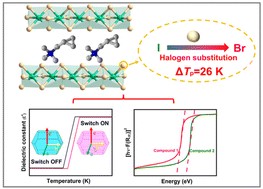The halogen substitution strategy of inorganic skeletons triggers dielectric and band gap regulation of hybrid perovskites†
Abstract
Organic–inorganic hybrid perovskites (OIHPs) with dielectric switching functions have aroused comprehensive scientific interest, benefitting from their promising applications in sensors and information storage. However, to date, most of these materials discovered thus far possess a single function and are limited in their applicability, failing to meet the requirements of diverse applications. Moreover, the discovery of these materials has been largely serendipitous. Building multifunctional OIHPs with dielectric switching and semiconductors remains a daunting task. In this context, by introducing [C7H16N]+ as cations and in combination with lead halide with semiconducting properties, two OIHPs [C7H16N]PbI3 (1) and [C7H16N]PbBr3 (2) ([C7H16N]+ = (cyclopropylmethyl) trimethylammonium) have been successfully designed. They have dielectric switching properties close to 253 and 279 K and semiconducting behavior with band gaps of 2.67 and 3.22 eV. The phase transition temperature increased by 26 K through halogen substitution. In summary, our findings in this study provide insights into the application of the halogen substitution regulation strategy and open up new possibilities for designing perovskite semiconductors with dielectric switching functionality.



 Please wait while we load your content...
Please wait while we load your content...